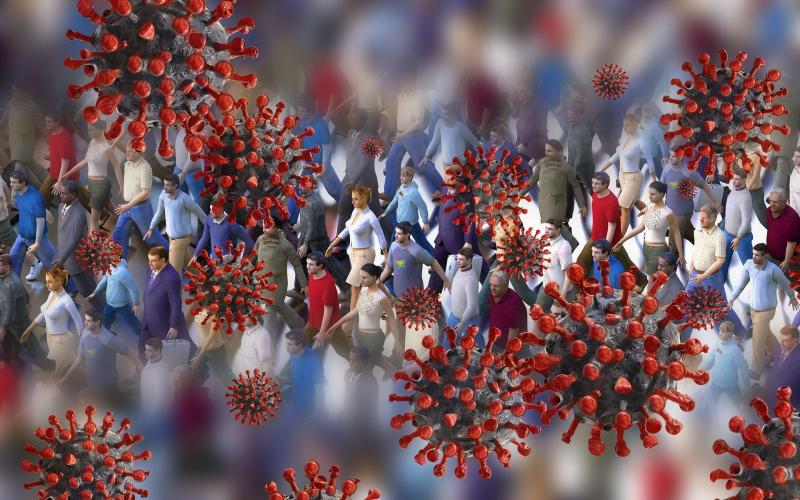
There is belated realisation among health experts, policymakers and elected representatives that the SARS Coronavirus type 2 (SARS-CoV-2) is here to stay. It will continue to cause the Covid-19 disease seasonally and sporadically until we get a vaccine, which will, even by optimistic estimates, take two years at least to be tested, cleared and mass produced. This means the strategy to fight the war must change. We will still need some protective measures. What would these measures look like?
Fear of the disease and stigma associated with it has led to anxiety, social disharmony and a rise in mental illnesses. In many parts of India, the perception still abounds that those with the virus must be “caught” and brought by police to hospitals that now sometimes carry the images of jails. Police guards, barricades, locked exits — all contribute to the image of an infected person as one to be shunned, locked in and forced to stay in hospitals. This carries the risk of people turning away from medical intervention for all diseases and vaccinations. We must end fear and stigma.
Police guards, barricades, locked exits — all contribute to the image of an infected person as one to be shunned, locked in and forced to stay in hospitals. We must end fear and stigma.
Inadequate understanding of the disease and how it spreads has also led to exaggerated fear. Governments also need to refrain from disclosing names and details of families affected by Covid-19 or of those who have returned from areas affected by Covid-19. The government of Odisha showed early on that it is possible to manage the epidemic while maintaining confidentiality. In the long run, addressing stigma is essential for managing an epidemic and reducing the harm, as the experience of the HIV epidemic has taught us.
We estimate that since we first started counting deaths due to Covid-19, about 2.5 million people would have died in India due to causes not related to Covid-19. In addition, the lockdown and scaling down of health services has led to significant reduction in provision and utilisation of health services. As a result, India may face lakhs of additional deaths in times to come. A modelling exercise by the Stop TB partnership showed that India is likely to see 150,000 to 500,000 additional deaths due to tuberculosis alone in years to come as a result of the lockdown, because of the disruption of TB-related health services. If we add up the impact on other conditions such as cancers, HIV and diabetes, the numbers of additional deaths would be considerable.
To prevent further loss, we have to resume the full scope of health services, with due caution, to minimise the incidence of Covid-19. Several healthcare organisations have shown that it is possible. The Tata Memorial Hospital decided early on to maintain its cancer care services, despite pressures from multiple sources to focus all its energies on Covid-19, to the exclusion of everything else. Lessons from this and other hospitals that ensured continuity of health care services would be helpful as other organisations resume services. Governments will have to issue clear guidelines that encourage and support all health care organisations, government or private, to resume the full scope of services.
India is likely to see 150,000 to 500,000 additional deaths due to tuberculosis alone in years to come as a result of the lockdown
At the moment, many Covid-19 cases are supposed to be managed at hospitals. For mild infections, there is no rationale for hospitalisation, since mild cases can stay at home and recover. We would of course need to adapt the principles of home isolation for rural areas or congested urban areas. In many rural areas, staying outdoors (in nearby fields or verandahs/compounds) is more feasible and more effective than staying indoors with other family members and cattle.
Also, moderately severe cases, which require supportive care and oxygen, can be managed at primary health care facilities. Increasingly, there are protocols for oxygen use, such as high flow nasal cannulae, which can be administered at primary care facilities, provided there is uninterrupted flow of oxygen. Such decentralised or distributed care would reduce anxieties among families, minimise risk of transmission and reduce overburdening of hospitals.
Surveillance is a backbone of any epidemic management. India’s extensive primary health care network and Integrated Disease Surveillance Programme are well suited to perform the surveillance of the epidemic, and provide timely and contextual evidence on which to base the containment measures. Integrating the surveillance of Covid-19 infections with existing surveillance networks would make it more efficient and “organic” than having a separate structure for capturing the necessary information.
Mild cases can stay at home and recover, while moderately severe cases can be managed at primary health care facilities. This will reduce the overburdening of hospitals
Lakhs of people, especially migrants, are forced to stay away from their families, in factories, work-sites, camps, or in quarantine centres. From a public health point of view, staying with families and in their own communities would enable much lesser spread and greater care. Staying in rural areas would also allow for closer surveillance. Once reunited and the anxieties allayed, migrants can take a call on how to resume their work, stay in rural areas or go back to urban areas.
Provision of improved housing and other amenities by host governments and employers would be crucial before migrant labour returns to the cities. The crowded and unsanitary conditions that they live in currently carry huge potential for transmission of the virus, besides being harmful in other ways.
(Mohan is a paediatrician, public health expert and co-founder of Basic Healthcare Services. Rattanani is a journalist and faculty member at SPJIMR.)








